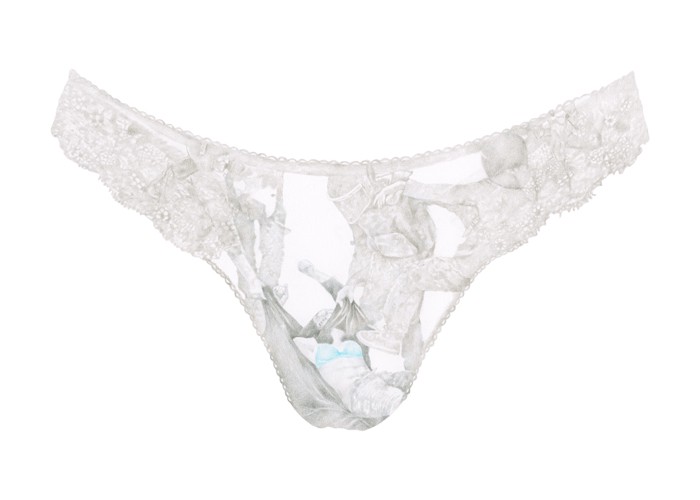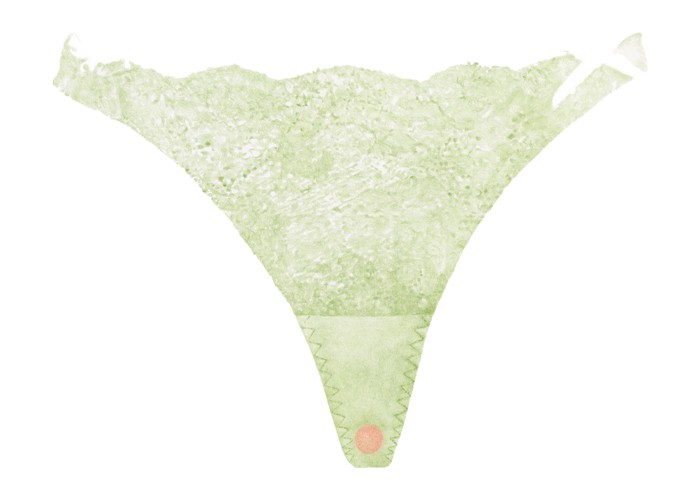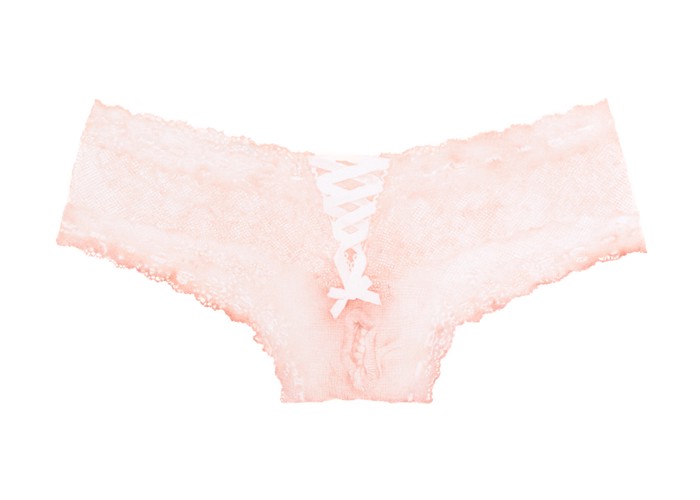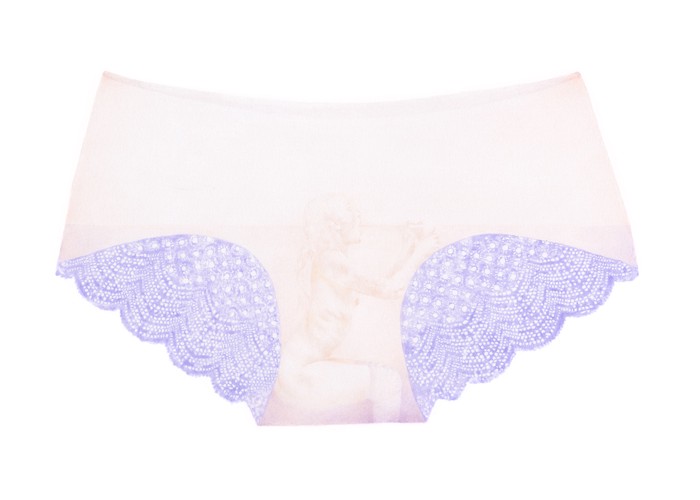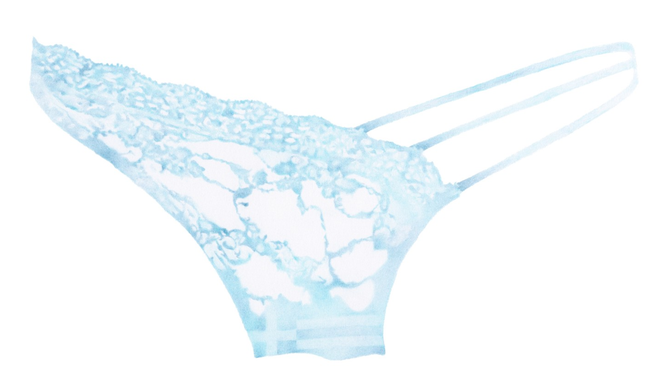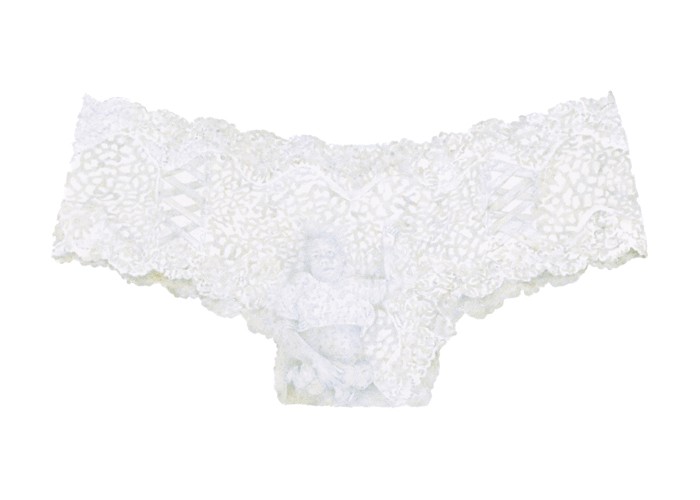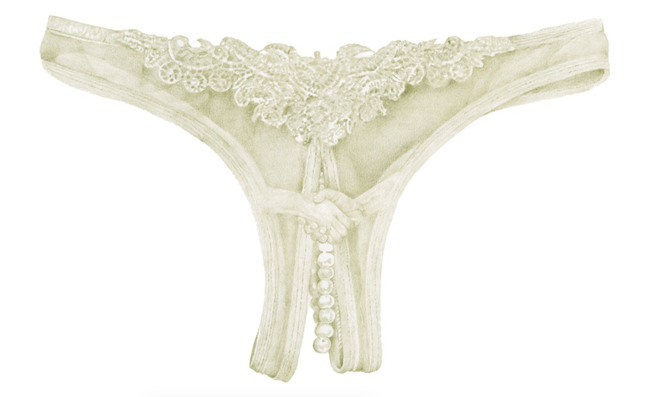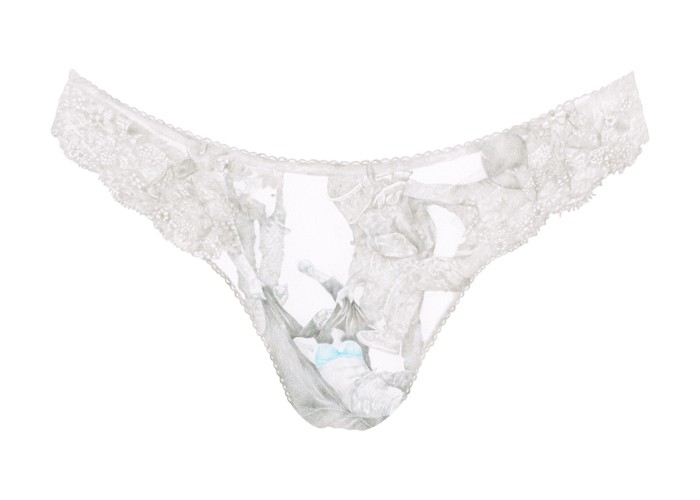VISUAL ART
The Nation In Our Underwear
Reina Gattuso on the Work of Artist Azita Moradkhani
♦
By REINA GATTUSO | 13 Oct 2015
Which Pair Are Yours?, colored pencil, 17" x 19", 2014
Azita Moradkhani, an artist who has lived most of her life in Tehran, begins our phone conversation by excusing her English. She just learned it, she tells me, a few years ago to move to the United States for graduate school: Two master’s programs — one in art education; one an MFA at the School of the Museum of Fine Arts, in Boston — in three years.
Even if that kind of apology were ever necessary (it’s not), it’s especially not needed here. Her flow of speech is melodic, quick, the same kind of entrancing as the patterns in her work. She has just come back from yoga. Out the window on my end, the crickets have just begun pining in the half-lit sweetgrass.
“Lingerie stores are very private in our country: Men can’t walk in and they are usually hidden in the malls,” she tells me.
Even if that kind of apology were ever necessary (it’s not), it’s especially not needed here. Her flow of speech is melodic, quick, the same kind of entrancing as the patterns in her work. She has just come back from yoga. Out the window on my end, the crickets have just begun pining in the half-lit sweetgrass.
“Lingerie stores are very private in our country: Men can’t walk in and they are usually hidden in the malls,” she tells me.
But Moradkhani, now living in the United States, found herself at the American lingerie behemoth, windows lined with slips of spandex and lace, models’ hips jaunting crocheted nothings over their crotches.
Moradkhani’s life and work were changing with her transition to the States.
“I found myself not in this place I know as home, I felt insecure and filled with self-blame, threatened and afraid, visible and invisible,” she says. “I found myself homeless in a new home space.”
She took a few pairs of the panties back to her studio.
Moradkhani’s life and work were changing with her transition to the States.
“I found myself not in this place I know as home, I felt insecure and filled with self-blame, threatened and afraid, visible and invisible,” she says. “I found myself homeless in a new home space.”
She took a few pairs of the panties back to her studio.
Last October, in a gallery space right outside one of my course lecture halls,a row of panties hung on a sketched-in clothesline.
They were sherbet-colored, frothy pinks and Cinderella blues, their delicate netting rendered in even more delicate colored pencil. When I walked up close (in the cool silence when one doesn’t mind being late to class; the click of my heels over the flooring), I saw that their crotches were stained with images.
They were sherbet-colored, frothy pinks and Cinderella blues, their delicate netting rendered in even more delicate colored pencil. When I walked up close (in the cool silence when one doesn’t mind being late to class; the click of my heels over the flooring), I saw that their crotches were stained with images.
Someone had menstruated pearls. A single red dot; an arching woman; fetal children curled. A grey pair washed with the ghostly image of a rape, men removing the garments of a woman inscribed on a garment herself; mesh forming the image of a sunglass-and-hijab-clad-woman.
But what made my eyes pause in their appraisal of the panties (80% nylon; 20% spandex) was the flags: A pair stained delicately saffron and green, decorated with a spinning wheel; an Israeli star bleached over pubic hair; Iranian reds and greens. Genitals gently tattooed with flags.
Moradkhani had made something out of those panties, her 2014 series Which Pair are Yours?
But what made my eyes pause in their appraisal of the panties (80% nylon; 20% spandex) was the flags: A pair stained delicately saffron and green, decorated with a spinning wheel; an Israeli star bleached over pubic hair; Iranian reds and greens. Genitals gently tattooed with flags.
Moradkhani had made something out of those panties, her 2014 series Which Pair are Yours?
In Moradkhani’s artwork, woman is nation, both its source, its purity, its internal, the home of the homeland — the womb from which warriors come; the keeper of tradition against the foreign invader; a vessel, a sack — but she is also, thereby, the threat of the nation’s undoing, a threat against which any action may be justified.
This is what I am struck by, as I stand in front of Moradkhani’s images: The flag as a brand, both a regulatory symbol seared onto our skin and the mark of international capitalist exchange. Moradkhani’s flag transposed onto the delicate yet mass-produced lace both censors and invites. Under this sign, any tempting false dichotomy — the lace panty versus the veil; sexual objectification against sexual repression — dissolves; we are branded equally by either. Both the market and the nation are complicit.
For Moradkhani, this dual sense of delicacy and violation was omnipresent in her Iranian childhood — and in her adult practice as an artist.
This is what I am struck by, as I stand in front of Moradkhani’s images: The flag as a brand, both a regulatory symbol seared onto our skin and the mark of international capitalist exchange. Moradkhani’s flag transposed onto the delicate yet mass-produced lace both censors and invites. Under this sign, any tempting false dichotomy — the lace panty versus the veil; sexual objectification against sexual repression — dissolves; we are branded equally by either. Both the market and the nation are complicit.
For Moradkhani, this dual sense of delicacy and violation was omnipresent in her Iranian childhood — and in her adult practice as an artist.
“If you’re going to expose yourself in the way you are, you have to expect some violence,” she says of life and art-making in Iran. “It’s not like you can say anything you want, you can wear anything you want on the street in public. That vulnerability can lead to violation.”
Moradkhani’s work is full of jewel-tones, florals that extend into abstraction, and the butterfly-like edges of women’s clothes. Their repetition feels narcotic, and it’s a pleasure that evokes the visual culture of Moradkhani’s childhood in Iran. “Part of it is connected to where I’m from, to my memory from childhood, being surrounded with beautiful, delicate patterns in the carpet, and the curtain and my grandma’s dress,” Moradkhani says.
Moradkhani’s work is full of jewel-tones, florals that extend into abstraction, and the butterfly-like edges of women’s clothes. Their repetition feels narcotic, and it’s a pleasure that evokes the visual culture of Moradkhani’s childhood in Iran. “Part of it is connected to where I’m from, to my memory from childhood, being surrounded with beautiful, delicate patterns in the carpet, and the curtain and my grandma’s dress,” Moradkhani says.
The patterns in Moradkhani’s work also mimic the potential for “violence and vulnerability” that comes with creative female embodiment. “Even this pleasure becomes like a pain, because overwhelming repetition of patterns can hurt your eyes physically or your mind sometimes,” she says. “It’s about pain and pleasure at the same time. It’s a pleasure to see the lingerie, but you draw closer and there is something happening. I use pleasure to get to the hidden narratives of violence that is enacted on the bodies of women, that we often ignore,” Moradkhani says.
Yes, the violence that has sunk surfaces in our pleasure.
Yes, the violence that has sunk surfaces in our pleasure.
Sometimes it comes out; sometimes in our sex there are still-unhealed edges; sometimes you are dancing in a bar and an errant comment springs a leak in your eyes and your heart as though you had hit a well. Because it is in us. Because sexual trauma, historical trauma, wash up sharply like those jagged-edged shells right at the ocean’s rim.
We are globes of pleasure and pain, repeated over and over again until we are turgid with the memory of it: Pleasure, pain, pleasure, pain, historical trauma and visual trauma. “The patterns are trauma, that repeat unconsciously regardless of aesthetics, pleasure that leads to pain and feeling overwhelmed,” Moradkhani says.
We are globes of pleasure and pain, repeated over and over again until we are turgid with the memory of it: Pleasure, pain, pleasure, pain, historical trauma and visual trauma. “The patterns are trauma, that repeat unconsciously regardless of aesthetics, pleasure that leads to pain and feeling overwhelmed,” Moradkhani says.
By this point in my and Moradkhani’s conversation — it is a heady summer night, violet light falling in through the windows like sugar clouds — it is almost dark. The crickets outside have begun, in earnest, to keen. Moradkhani quotes Charlotte Perkins Gilman’s “Yellow Wallpaper” — a story, she says, that she thinks about a lot: “I will follow the pointless pattern to some kind of conclusion.”
Reina Gattuso writes about sex, queerness, pop culture, and institutional equity. She’s a weekly columnist for Feministing, and her work has appeared at attn:, Bitch, and The Washington Post. Reina is currently researching queerness in contemporary Bollywood as a Fulbright fellow at Jawaharlal Nehru University in Delhi, India. You should follow her on twitter and check out more of her work at her swanky website.
